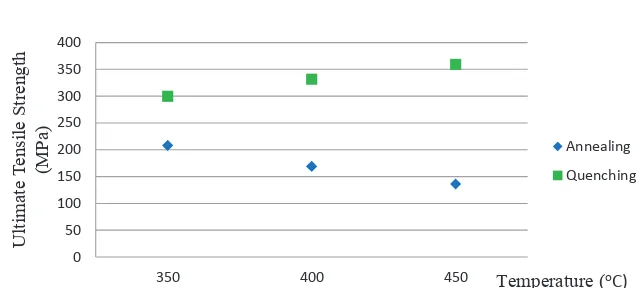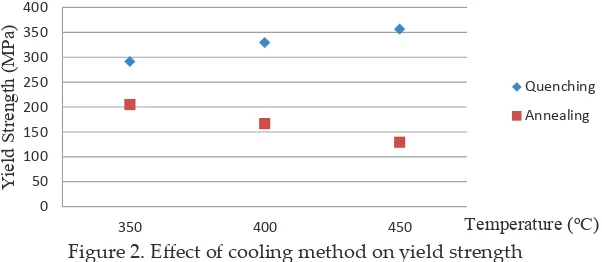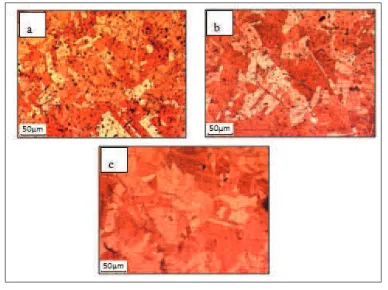EFFECT OF COOLING RATE ON MICROSTRUCTURES
AND MECHANICAL PROPERTIES OF C102 COPPER
ALLOY
J. Ridhwan1*, M. Syaiq2, M. H. M. Haidzal3,
M. S. Zakaria5, M. A. M. Daud6
1,2Center of Advanced Research and Energy,
Faculty of Mechanical Engineering, Universiti Teknikal Malaysia Melaka, Hang Tuah Jaya, 76100 Durian Tunggal, Melaka, Malaysia
ABSTRACT
The objective of this study is to illustrate the efect of two types of heat treatment on microstructure and mechanical properties of C102 copper alloy. Annealing and quenching were conducted to study the efect of cooling rate on material. Specimens were heated at 350, 400 and 500oC
and were cooled by using two types of cooling medium; furnace cooling and water quench. Tensile strength of 254.6 MPa was obtained for the as-received specimen. It was shown that an increase in cooling rate contributed to a higher strength due to local strain efect. Rapid cooling in quenched specimen had successfully increase the hardness by 41% and recorded the highest tensile strength of 359 MPa while slow cooling rate which experienced by an annealed specimen resulted in the lowest tensile strength of 136 MPa. Microstructure investigation shows annealed specimen produced coarse austenitic structure with larger grain size. Meanwhile, quenched specimen produced iner austenitic structure with smaller grain size. It was observed that the grain size of annealed specimen was increased with soaking temperature, however, quenched specimen shows the other way around.
KEYWORDS: Copper alloy; cooling rate; annealing; quenching
1.0 INTRODUCTION
Copper is an essential element for major industrial metal because of its high ductility, malleability, thermal and electrical conductivity and resistance to corrosion. Copper and its alloy mainly used in wiring production, piping, automotive and architecture. Heat treatment
process was applied on copper and copper alloys in order to atain the
Annealing is the heat treatment process where a metal or alloy acquires a structure close to the equilibrium state. A material is exposed to an elevated temperature for an extended time and then slowly cooled. Normally, annealing is carried out to relieve stress, increase softness and ductility. The temperature of heating in annealing depends on the composition of an alloy and the particular kind of the process; the rate of cooling from the annealing temperature is usually not high. There are varieties of annealing heat treatments possible. These are characterized by the changes on the microstructures and are responsible for the alteration of the mechanical properties (Zhang, 2007). Based on previous study, the recrystallization temperature was determined
by measuring the micro hardness in the side surface for diferent
annealing temperatures. The recrystallization temperature of a material is characterized by softening due to the decrease in dislocation density and the nucleation of new grains. Annealing in the recrystallization temperature causes a large drop in hardness (Kakani, 2004).
The most widely used and the oldest heat treatment process are quenching. Quenching involves heating the metal part above a temperature, which causes a change in microstructure, and then rapid cooling to force an unusual change in the microstructure which not formed on slow cooling. Quenching is the procedure used for cooling copper alloy that basically use the water as a medium. Because most metals are cooled rapidly during the hardening process, quenching is usually associated with hardening (Klinger, 2002).
Although there are several studies conducted on copper alloy, however, there are only few of study regarding heat treatment of C102 copper
alloy that can be found. Hence, this study intended to analyze the efect
of cooling on microstructure and mechanical properties of C102 copper alloy.
2.0 MATERIALS AND METHODS
2.1 Specimen Preparation and Heat Treatment
The yield strength and tensile strength for the as-received material are 211.37 MPa and 254.6 MPa respectively.
2.2 Mechanical Testing and Microstructure Investigation
ASTM E-8 (Standard Test Method for Tension Testing of Metallic Materials, 2010) was referred for tensile test on specimen using INSTRON Universal Testing Machine. The extension rate set for the machine is 5.00 mm/min. Yield strength and the ultimate tensile strength were recorded for each specimen.
For metallurgical investigation, the specimens were mounted and followed by grinding and polishing to obtain the mirror surface. The specimens are then etched on Marble mixture solution to reveal the microstructure. The grain size of the specimens was measured by using Lineal Intercept Method, ASTM E-112-10. (Standard Test Method for Average Grain Size, 2010). Grain size is measured with a light microscope by determining the number of grain boundaries that intersect with a given length on selected test area.
3.0 RESULTS AND DISCUSSION 3.1 Tensile properties
Table 1 shows the yield strength and ultimate tensile strength value of annealed and quenched specimens. Figures 1 and 2 show the trend of ultimate tensile strength and yield strength for annealed and quenched specimens respectively. Quenched specimens show increase in tensile strength from 299 to 359 MPa as the soaking temperature increased from 350 to 450oC. On the other hand, annealed specimens show decreased in tensile strength from 208 to 136 MPa. These indings show that the strength of annealed and quenched materials is highly afected by the soaking temperature. This inding is consistent with Ridhwan et
al. (2013) and Mao et al. (2009).
The decreasing in strength for annealed specimens can be atributed
to several factors. Habibi et al. (2011) states that dislocation density of grain plays a main role in the strength changes. Since annealing can reduce the dislocation density of material by recovery action, thus, the
decrease in strength can be atributed to the reduction of dislocation density. A dislocation is latice efects which play a main role in plastic
of material. On the other hand, since annealing temperature was set beyond the desired temperature of recrystallization, the new strain-free grains are heated that leads to a progressive increase in grain size. Furthermore, at higher annealing temperature, second-phase particles which inhibit grain growth will dissolve progressively and results to coarsening of grain. Thus, this coarser grain structure leads to the softening of the material and the reduction of strength (Dieter et al., 2012; Ridhwan et al., 2013).
The increase in strength for quenched specimen was discussed by Perry et al. (2006) where by preserving the solid solution formed at the solution heat-treating temperature by rapid cooling, solute atoms that precipitate on grain forced the vacancies to migrate into disordered regions that contribute to the subsequent strengthening. The loss of vacancies on the structure induces to the clustering of the grain structure. Local strain is produced by the clustered region which leads to the hardening of the structure. In addition, the formation of coherent alloy phase also responsible for material strengthening (Nagarjuna et al., 2001). This hardening mechanism explains the increased in strength for quenched specimen.
Table 1. Tensile properties of quenched and annealed copper alloy based
Quenching 291 299 329 331 356 359
Annealing 205 208 167 169 129 136
0 Figure 2. Efect of cooling method on yield strength
3.2 Microstructure Investigation
Both annealed and quenched specimens show austenitic structure after heat treatment. Figure 3 shows that the microstructure of annealed specimen experienced grain coarsening as the annealed temperature increases. This is due to the grain growth and reduction of dislocation. This behavior explained the decrease in strength of annealed specimens. The grain growth phenomenon was caused by decreasing of surface energy which has been mentioned on the previous section. On the other hand, quenched specimens show decrease in grain size (Figure 4). This is because during quenching, the grains become clustered and
iner grain structure was observed. The clustering was produced by the
loss of vacancies on the structure as mentioned in the previous section. Thus, higher temperature results to higher loss of vacancies.
Further analysis was conducted on the microstructure of annealed and quenched specimens by calculating the grain size number based on ASTM standard. In this standard, smaller number represent larger grain. Figure 5 shows the grain size number for quenched and annealed specimens. The annealed specimens undergone reduction in grain size number with increase of annealing temperature. The grain size number was slightly decreased from 5.2 to 4.1 which indicated that the grain has growth as the temperature increases. Meanwhile, quenched specimens show increment of grain size number with increase of soaking temperature. Highest grain size number of 8.2 was measured at 450oC which also represent the highest strength specimen in this study. The increased in grain size can be atributed to the dissolution of
pinning particles at higher temperature which allowed grain growth to occur (Ridhwan et al., 2013). On the other hand, eventhough the grain size was increased for quenched specimen; however this phenomenon
does not decrease the strength of material due to the local strain efect
ISSN: 2180-1053 Vol. 6 No. 1 January - June 2014 92
icrostructure of annealed copper alloy at (a) 350oC (b) 400oC Figure 3. Microstructure of annealed copper alloy at
(a) 350oC (b) 400oC and (c) 450oC
o
Figure 4. Microstructure of water quenched copper alloy at (a) 350oC (b) 400oC and (c) 450oC
• 0 1 2 3 4 5 6 7 8 9
350 400 450
G
ra
in
s
iz
e
n
u
mb
e
r,
G
Annealing
Quenching
Temperature (oC)
Figure 5. Efect of cooling rate to the grain size number
4.0 CONCLUSION
Analysis on the microstructure and hardness of heat treated C102 copper alloy has led to few conclusions:
• Quenched specimens which subjected to high cooling rate have
higher strength as compared to annealed specimens due to local
strain efect. Highest tensile strength of 359 MPa was recorded at
450oC soaking temperature which is 163% higher than annealed specimen. On top of that, higher soaking temperature results to increase in strength for quenched specimen, but decrease the strength of annealed specimen.
• In terms of microstructure, grain growth was observed for
annealed specimen with increases in soaking temperature due to dissolution of pinning particles from the grain boundary.
Quenched specimen shows iner grain after heat treatment due to grain clustering efect.
ACKNOWLEDGEMENT
The authors wish to thank Faculty of Mechanical Engineering, Universiti Teknikal Malaysia Melaka (UTeM) for providing the facilities
and inancial support to conduct this research activity.
REFERENCES
ASTM Standard E8M. (2010). Standard test method for testing of metallic materials (metric). West Conshohocken, PA: ASTM International.
ASTM Standard E112. (2010). Standard test method for determining average grain size. West Conshohocken, PA: ASTM International.
Dieter, G. E. (2012). Mechanical metallurgy, annealing and average grain size, 191-193, 233–236.
Habibi, A. & Ketabchi, M. (2012). Enhanced properties of nano-grained pure copper by equal channel angular rolling and post-annealing. Materials & Design, 34, 483–487.
Kakani, S. L. & Kakani, A. (2004). Material science. New Age International Publisher.
Nagarjuna, S., Sharma, K. K., Sudhakar, I., & Sarma, D. S. (2001). Age hardening studies in a Cu–4.5Ti–0.5Co alloy. Materials Science and Engineering A313, 251–260.
Nunes, R. M., Arai, T., & Baker, G. M. (2001). Heat treatment of non-ferrous alloy. ASM Handbook Vol. 4, 1884–1956.
Ridhwan, J., Hamzah, E., Efendy, H., Selamat, M. Z., Zulfatah, Z. (2013). Efect of cooling rate on the microstructures and hardness of
Fe-Ni-Cr Superalloy. Journal of Mechanical Engineering and Technology, 5(1), 45–57.
Ridhwan, J., Hamzah, E., Efendy, H., Selamat, M. Z., Zulfatah, Z., & Haidzal, M. H. M. (2013). Efect of aging treatment on the microstructures and
hardness of Fe-Ni-Cr superalloy. International Journal of Automotive and Mechanical Engineering, 8, 1430–1441.
Trophe, M. (2003). Nonferrous alloys and pure metals, metals handbook ninth edition volume 2–Properties and selection: Materials Park (OH)7 ASM International, pp. 280.
Zhang, Z., Lin, G., Zhang, S. & Zhou, J. (2007). Efects of Ce on microstructure


